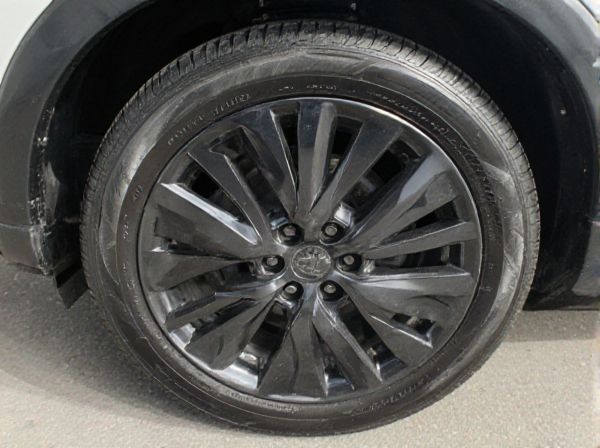
Photo illustration: Silent Tire vs Standard Noise
Silent tires significantly reduce road noise compared to standard tires, enhancing driving comfort and minimizing distractions. They incorporate specialized materials and tread patterns designed to absorb sound vibrations, leading to a quieter cabin environment. Choosing silent tires can improve Your overall driving experience, especially on long journeys.
Table of Comparison
| Feature | Silent Tire | Standard Tire |
|---|---|---|
| Noise Level | Low noise emission, typically under 65 dB | Higher noise emission, usually around 70 dB or more |
| Tread Design | Optimized for noise reduction with special pattern | Conventional tread with less focus on noise |
| Comfort | Enhanced cabin quietness and smoother ride | Standard cabin noise levels |
| Durability | Comparable lifespan, focused on noise and comfort | Standard durability based on tire type |
| Price | Generally higher due to advanced technology | More affordable, widely available |
| Typical Use | Ideal for city driving and long-distance comfort | Suitable for general driving conditions |
Introduction to Silent Tires vs Standard Noise
Silent tires utilize advanced sound-absorbing materials and innovative tread designs to significantly reduce road noise compared to standard tires, enhancing overall driving comfort. Standard tires typically produce higher noise levels due to rigid tread patterns and less sound-dampening technology, resulting in increased cabin noise and driver fatigue. The development of silent tire technology integrates acoustic foam layers and optimized rubber compounds, targeting the reduction of vibration and sound wave transmission.
How Silent Tires Work
Silent tires reduce road noise by incorporating specialized internal foam layers or sound-absorbing materials that dampen vibrations caused by tire tread patterns. These technologies minimize air resonance within the tire cavity, effectively decreasing the audible noise transmitted into the vehicle cabin. Compared to standard tires, silent tires enhance driving comfort by delivering a quieter ride without compromising performance or durability.
Key Differences Between Silent and Standard Tires
Silent tires utilize advanced sound-absorbing materials and innovative tread designs to reduce road noise significantly compared to standard tires, enhancing cabin comfort. Standard tires typically prioritize cost and durability, resulting in higher noise levels due to less effective noise-dampening technologies. The key differences lie in noise reduction efficiency, tread pattern engineering, and material composition, making silent tires ideal for quieter rides without compromising performance.
Benefits of Silent Tires
Silent tires significantly reduce road noise, enhancing driving comfort and minimizing noise pollution in urban areas. Their advanced tread design and specialized rubber compounds absorb vibrations, leading to a quieter cabin experience and less fatigue during long drives. These tires also improve overall vehicle acoustics, contributing to a more peaceful and enjoyable ride.
Performance Comparison: Silent vs Standard Tires
Silent tires use advanced noise-reducing tread patterns and specialized rubber compounds to minimize road noise, enhancing driving comfort without sacrificing grip or handling. Standard tires provide reliable traction and durability but often generate higher levels of noise, especially at highway speeds and on rough surfaces. Performance comparison indicates silent tires maintain equivalent braking distances and cornering stability while significantly reducing interior cabin noise for a quieter ride.
Noise Reduction Technologies in Tires
Silent tires utilize advanced noise reduction technologies such as specialized inner liners, sound-absorbing foam, and optimized tread patterns to significantly lower road noise compared to standard tires. These features reduce the vibrations and air pumping effects that generate sound, enhancing driving comfort especially on highways and urban roads. In contrast, standard tires lack these engineered elements, resulting in higher noise levels transmitted into the vehicle cabin.
Fuel Efficiency: Silent Tires vs Standard Tires
Silent tires feature advanced tread designs and optimized rubber compounds that reduce rolling resistance, directly enhancing fuel efficiency compared to standard tires. Lower rolling resistance decreases the energy required to maintain vehicle speed, resulting in measurable fuel savings over time. Studies indicate that vehicles equipped with silent tires can achieve up to a 3-5% improvement in fuel economy relative to those using conventional tire models.
Cost Analysis: Silent Tires vs Standard Options
Silent tires typically come at a higher upfront cost compared to standard tire options due to advanced noise-reducing materials and technology incorporated in their design. While the initial investment is greater, silent tires can offer long-term savings by enhancing fuel efficiency and reducing cabin noise, which may lower driver fatigue and associated indirect costs. Cost analysis must also consider potential maintenance expenses, as silent tires often feature specialized compounds that can influence durability and replacement frequency compared to standard tires.
Best Use Cases for Silent Tires
Silent tires are best suited for urban environments and electric vehicles where noise reduction enhances comfort and reduces noise pollution. Their advanced tread design and sound-absorbing materials minimize road noise, making them ideal for long highway commutes and residential areas. Standard tires perform well in diverse conditions but lack the specialized noise-dampening features that improve driving experience in quiet settings.
Choosing the Right Tire for Your Driving Needs
Silent tires reduce road noise significantly compared to standard tires, enhancing driving comfort on highways and city streets. They incorporate advanced tread patterns and sound-absorbing materials to minimize vibrations and acoustic disruptions. Selecting the right tire depends on your driving environment, prioritizing quiet rides for urban commutes or durability and traction for off-road or performance needs.
 caratoz.com
caratoz.com